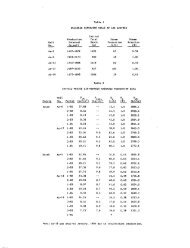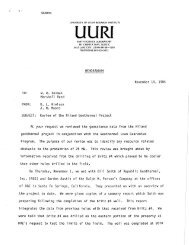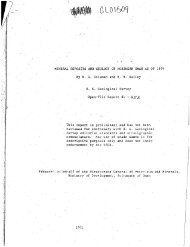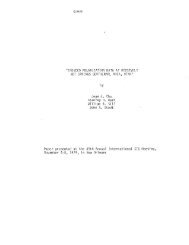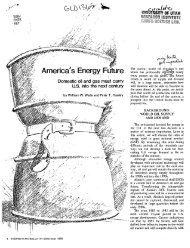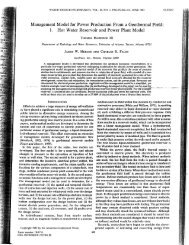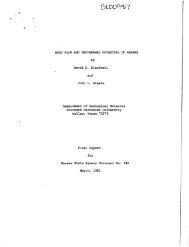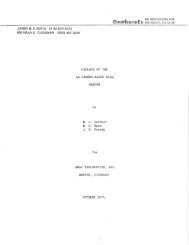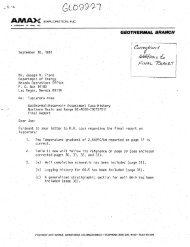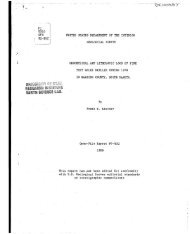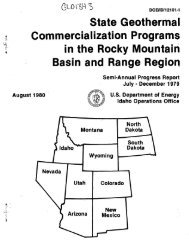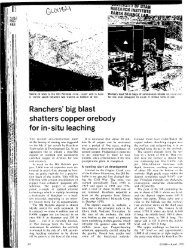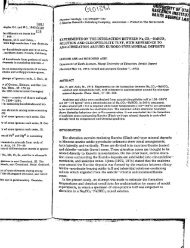Figure I Generalized map of the Wilbur Mining ... - University of Utah
Figure I Generalized map of the Wilbur Mining ... - University of Utah
Figure I Generalized map of the Wilbur Mining ... - University of Utah
Create successful ePaper yourself
Turn your PDF publications into a flip-book with our unique Google optimized e-Paper software.
The' following four^ types <strong>of</strong> piping systems<br />
were investigated:<br />
- Steel Pipe in a Concrete Tunnel (350°F Maxiraura<br />
Temperature). This type systera is essentially<br />
a poured-iri-place or precast reinforced concrete<br />
tunnel with removable'concrete lids, which ca'h be<br />
used for sidewalks, and renraved to provide access<br />
for maintenance or insiiallation <strong>of</strong> future p.ipeS;.<br />
The insulated carrier pipes'are supported on steel<br />
rollers which are imbedded into <strong>the</strong> concrete tunnel,<br />
hfter installation, piges are insulated with<br />
preformed fiberglass or rPckwool. Allowance for<br />
expansion is by\a bellows type expansion .joint<br />
which is dual acting with an anchor.between <strong>the</strong> bel-<br />
1 ows. The pipe is al so free to expand at elbows<br />
with <strong>the</strong> use <strong>of</strong> guides. The concrete tunnel is<br />
placed on a gravel bed which contains a dizain tile.<br />
The concrete tunnel is extremely durable, can be<br />
used for o<strong>the</strong>r utilities, arid can be; constructed by<br />
local contractors. Its main drawbaek is that it is<br />
expensive to .construct compai-ed to o<strong>the</strong>r type systems<br />
.<br />
Concrete tunnel type pi pi rig is popular in<br />
European district'heating systeras and <strong>the</strong> Icelanders<br />
who usually use it for pipes larger than 10 inches,<br />
in diameter, -claim <strong>the</strong>re is no better system.<br />
CONCBETE TFffiNirf)<br />
INSULATION<br />
sreeL PIPE<br />
ROLLER PW)<br />
'BACKfiLL<br />
GBAVEL BED<br />
FIGURE 5. Steel Pipe in a Concrete Tunnel<br />
Steel Pipe in a Protective Co.verinn ,(25D°F<br />
Maximum Temperature).- A single carrier pipe- is enclosed<br />
in polyurethah irsulation with a. tight jacket<br />
<strong>of</strong> glassfiber reinforced piasti'c (FRP) <strong>of</strong> PVC.,<br />
Joints <strong>of</strong> pipe are welded, insulated, and sealed<br />
with a joint kit and placgd in a bed <strong>of</strong> sand in <strong>the</strong><br />
CLASS 8 BED<br />
FRP JAGKET<br />
URETHANE INSULATION<br />
STEEL RIPE<br />
FIGURE 6. Steel Pipe in a Protective Covering<br />
trench. Manholes are constructed between anchor's<br />
to house <strong>the</strong>! expansion bel Vows and insulation<br />
around elbows is oversized to allow expansiori.<br />
There are usually eight segments (320. ft) between<br />
an anchor and manhole, <strong>the</strong> manholes are construeted<strong>of</strong><br />
reinforced concrete; with drain provisions, this<br />
type system is very durable, r^esistant to external<br />
corrosion^ however, susceptible to exterior cdrro-<br />
391<br />
Lund j et. al.<br />
sion. Although costs per lineal foot are comparableto<br />
rion-TCtallic pipe, <strong>the</strong> added cost for manholes<br />
arid expansion bellows makes it more expensive.<br />
Fiberglass Reinforced Plastic Pipe (FRP)<br />
(.210°F Maximum temperatureT^ A .single: FRP carrier<br />
pipe is enclosed in polyurethane insulation with a<br />
tight jacket <strong>of</strong> FRP or PVC. The pipe is a filament<br />
wound fiberglass with ei<strong>the</strong>r epOxy or polyester<br />
resin plastic. The epoxy type can handle<br />
temperatures up to 350°F 'a'nd has a low coefficient<br />
<strong>of</strong> roughness, C = 140. The pipe, usually does not<br />
have any expansion joints,, as <strong>the</strong> co.efficient <strong>of</strong><br />
linear expansion is 8.5 x 10^^ per °F as corapared<br />
to 12 X., 10"^ per °F I'or steel pipe. Elbow_s are located<br />
in poured concrete thrust blocks in Order to<br />
hold <strong>the</strong> pipe in, position and allpw expansion in<br />
straight lengths. A polyester resin pipe <strong>of</strong> this<br />
type failed recently when it pulled apart, raairily<br />
,a;t joints, when <strong>the</strong> pipe cooled. There is available<br />
pn <strong>the</strong> market a slip-ring type joint.tha't may<br />
be more desirable than <strong>the</strong> epoxy jpiried pipes. A<br />
check On <strong>the</strong> filament wound epoxy resin pipe installation,<br />
carrying .353°F'water", proved satisfactory,<br />
hov/ever, flashing must never occur in FRP<br />
pipe. In areas wHer^e flashing conditions' are expected,<br />
steel pipe sections must be used. The main<br />
'advantages <strong>of</strong> this type piping systera is its resistance<br />
to corrosion and Tow roughness coefficient.<br />
BACKFILL<br />
FIGURE 7\ Insulated FRP Pipe<br />
CLASS B BE13<br />
PVC JACKET<br />
URETKANE INSULATION<br />
FRP PIPE<br />
Asbestos Cement Pipe (AC) (200°F Maximum<br />
Teraperature). This type.pipe has ^an epcfxy 'lined<br />
AC 'carrier' pipe, polyurethane insulation arid an AC<br />
•^^^



